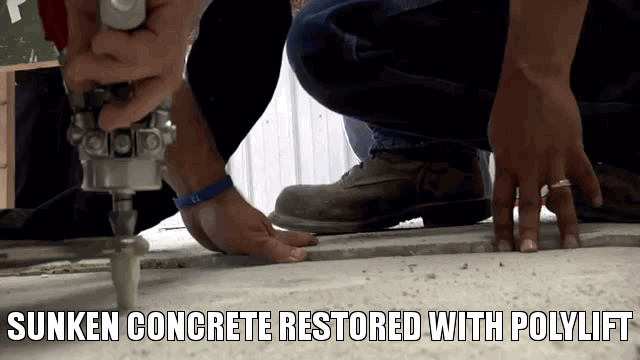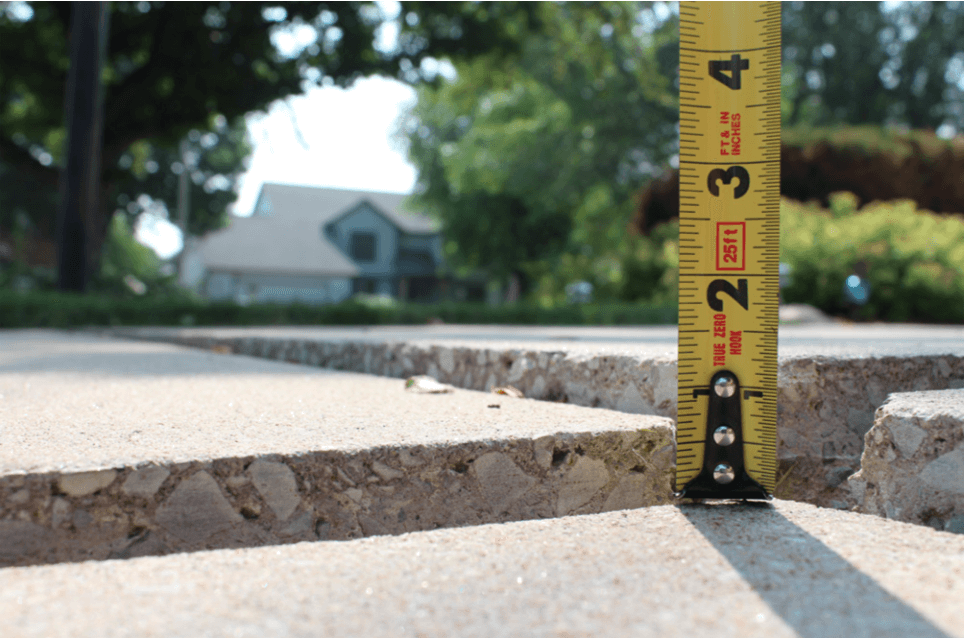Concrete structures are subject to a wide variety of environmental stresses, many of which can cause damage, like cracks, heaving or sinking. Once settlement begins, these problems almost always get worse over time as the soil beneath the structure continues to erode. When concrete leveling issues arise they can often be fixed and there are two main methods to raising concrete; mudjacking or polyurethane foam jacking.
One of the gravest threats to the structural health of your home is the sinking or settling of your concrete foundation. A foundation is built to stabilize the entire home, but cannot preserve its shape or structural integrity when the ground beneath it no longer provides strong and steady support.
This can happen when the soil beneath a concrete slab becomes inadequately packed (low in density) or overly water absorbent (causing expansion). As the soil collapses or goes through a cycle of expansions and contractions, the overlying concrete will heave, bend and ripple, and over time sink progressively deeper into its own footprint.
The good news is that if you encounter this problem in your own home, a variety of solutions exist.
While underpinnings are usually the best option, some homeowners may opt for mudjacking or slabjacking using polyurethane injection depending on their home improvement goals. These two common foundation repair procedures can each help halt and reverse the sagging of your concrete slab foundations, and neither involves excessive inconvenience or massive life disruption – but which one works best?
Mudjacking and Polyurethane Injection: The Basics
When foundations begin to sink, it’s usually because voids exist underneath the concrete slab, and until the soil is reinforced and those voids are filled, it will be impossible to restore the foundation to its previous level of elevation without the use of underpinnings.
Mudjacking and polyurethane injection (or polyjacking) work to fill the voids in the soil under the structure, and help halt the unfolding catastrophe. Mudjacking lifts the concrete foundation up on a densely-packed, swelling wave of slurry (a mixture of hard fill including mud, sand, cement, crushed limestone, etc.), while polyurethane injection raises the concrete by utilizing dense, durable, environmentally-safe polyurethane foam.
In each case, holes are drilled in the floor that penetrate through the concrete foundation and into the sunken spaces below (mudjacking holes are bigger and harder to patch). The slurry or foam is then injected in massive, concentrated quantities, enough to fill the underlying cavities and gradually lift the foundation (and all the weight above it) back to an adequate position. Once the technicians monitoring the procedure are satisfied they’ve added enough foam or slurry to support the concrete slab indefinitely, they will fill and repair the injection holes so the home’s floor looks as good as new.
These technologies are designed to restore sunken concrete foundations, but they can also lift many other concrete installations that might suffer the same fate. Polyurethane injection can be used to repair sinking swimming pools, roads, patios, sidewalks, driveway leveling, garage floors or even outdoor basketball courts quickly and efficiently.
A Comparative Analysis
While these two concrete lifting technologies are roughly analogous in function and short-term effectiveness, there are some differences between mudjacking and polyurethane injection you should take into account before you choose one over the other.
In general, mudjacking is less expensive and faster option than full concrete replacement but has several disadvantages like long drying time and the potential for additional damage. Polyurethane concrete raising leads to a longer-lasting and quicker repair, and it is a more precise operation than mudjacking.
Here is a list of the pros and cons of each concrete repair method:
Mudjacking
Pros
- This is a fairly inexpensive procedure.
- Mudjacking is a time-tested service that many contractors are familiar with.
- The injection slurry is largely constructed from naturally occurring materials with no negative environmental impact.
Cons
- The slurry is too rough in texture to completely fill underlying voids below a concrete slab, increasing the likelihood of further sinking in the near future.
- Mudjacking can last for long periods, but it is inherently less reliable and usually does need to be replaced.
- The injected materials are extremely heavy (30-50 times heavier than their polyurethane equivalent) and can cause a new round of soil compression (and foundation sinking) beneath the slab.
- The slurry materials are prone to washing out if exposed to underground water penetration through heavy rainfall, poor drainage, underground water pipe leaks, etc. (these are common causes of foundation damage).
- Large holes must be made in flooring
- Mudjacking equipment is cheaper than polyurethane equipment and materials.
Polyurethane Injection
Pros
- Polyurethane injection is a long-lasting procedure.
- Lightweight materials are used that will not cause additional soil compression and will flow easily during the injection process.
- The polyurethane density is sufficient to completely fill cavities below a sinking foundation.
- The soil below the foundation will mix well with the polyurethane and gain greater strength as a result.
- A feature of polyurethane that will make the end results more attractive is a smaller injection hole. Polyurethane utilizes a hole that is only 5/8” or smaller, compared to mudjacking holes that run between 1” and 2”.
Cons
- Fewer contractors have access to this procedure and it is not as widely available to homeowners as a result.
- Equipment and materials are expensive and often not available to smaller contractors that specialize in residential work.
Video Overview – How Polyurethane Injection Differs from Mudjacking when it comes to concrete leveling
In this short video we explain how polyurethane injection works, how mudjacking works, and what you can expect after the repairs are made.
Use Olshan’s PolyLift™ to Recover Sunken Concrete in Minutes
While many concrete contractors do not offer polyurethane injection as a repair option, at Olshan we’re intimately familiar with this innovative technology. Traditionally reserved only for commercial businesses and complex industrial projects, we have been leading the charge to make polyurethane injection accessible and affordable to homeowners. Our PolyLift™ structural repair methodology is quick, clean, effective and economical.
For most homeowners, the PolyLift™ system will inevitably produce longer lasting results than the older, less precise mudjacking procedure. Once our polyurethane layer is in place it will help your foundation or concrete structure stand firm against further heaving, buckling or water damage.
If you’re tired of dealing with a sinking foundation, driveway, sidewalk, pool or patio, the PolyLift™ system could be a home run for you. Your initial consultation and estimate are entirely free, so you’ll know exactly what you’re getting into before you give us the go-ahead. We may even be able to price your repair over email if you can provide some photos and measurements. Just give us a call!
Our neighbors in Aurora should be sure to check out our new Aurora Colorado foundation repair page and location!



